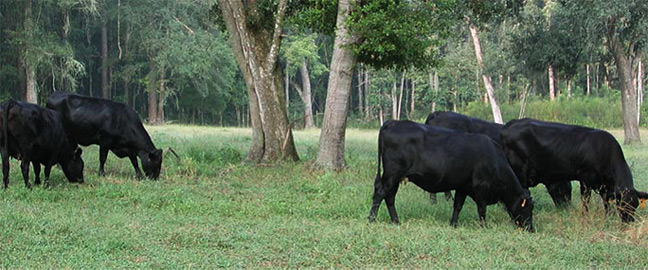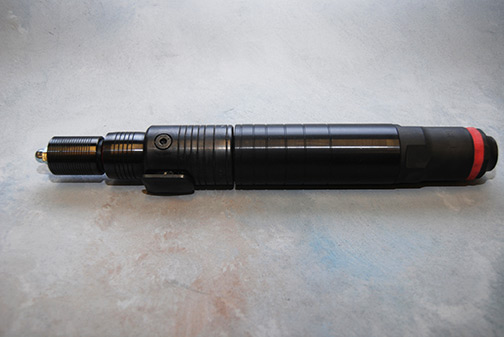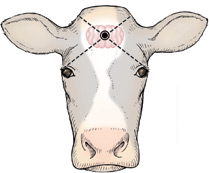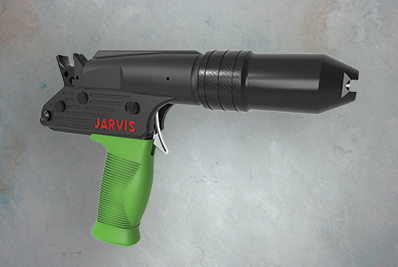
Properly applied, euthanasia by either gunshot or penetrating captive bolt (combined with procedures to ensure death), causes less fear and anxiety and induces a more rapid, painless, and humane death than can be achieved by most other methods. However, both methods may involve human risk, and therefore, require skill and experience. Neither method should be attempted by untrained or inexperienced persons.
Gunshot
In most circumstances on the farm or ranch, gunshot is the only practical method of euthanasia. This procedure requires the selection of an appropriate firearm and bullet with sufficient velocity, energy and size to pass through the skull (enter the brain), and cause massive brain destruction. A .22 caliber long rifle solid point bullet fired from either a pistol or rifle is sufficient for young animals. Hollow or soft point .22 caliber bullets increase brain tissue destruction, but may not penetrate the skull in adult animals and are therefore, not recommended. Euthanasia of bulls and some adult cows, horses, or cervids (elk) by gunshot requires larger caliber firearms, because of thickness of the skull. Proper placement of the bullet is essential and best achieved by holding the firearm within 2 to 3 feet (60 to 90 cm) when possible of the intended target. The muzzle of the firearm should not be held or placed against the head.
Shotguns are an excellent alternative to rifles or handguns for conducting euthanasia procedures. As with rifles and handguns, they must be used at close range, preferably within 1 to 2 yards (1 to 2 meters) of the intended target. Options for mature cattle (including bulls), horses and elk include the 12, 16 and 20 gauge shotgun loaded with slugs or No. 2, 4, or 6 size birdshot. The .410 and 28 gauge shotguns should not be used on larger animals, particularly bulls.
- Advantages: When properly positioned a bullet, birdshot from a shotshell or a slug will cause massive brain destruction and immediate unconsciousness. Gunshot is inexpensive and does not require close contact with the animal.
- Disadvantages: Gunshot may be dangerous. When using a rifle or handgun, ricochet of the bullet is possible and therefore, the operator and bystanders must use extreme care in positioning of themselves and others when the procedure is performed. Another disadvantage is, that in cases involving fractious animals, it may be difficult to get close enough to accurately hit the vital target area.
Whereas most animals for which euthanasia by gunshot is indicated are either debilitated or down, opportunity for proper placement of the bullet is less difficult. On the other hand, for animals on their feet and mobile or potentially dangerous, it may be necessary to shoot from a distance. In such cases, the preferred target areas are the head, neck, or lower thorax just behind the elbow.
Penetrating Captive Bolt
Penetrating captive bolt followed by immediate exsanguination (bleeding out) is the preferred method for euthanasia of cattle in abattoirs (slaughter facilities). The mode of action of a penetrating captive bolt gun is concussion and trauma to the brain. This requires that it be held firmly against the surface of the head over the intended site. This constitutes a major difference between the placement of a firearm and the placement of a penetrating captive bolt. Because placement and positioning of the projectile is critical, some degree of restraint is required for proper use of this device. A rope halter is sufficient to restrain the head for ensuring proper placement of the penetrating captive bolt.

Schermer KR Stunner Standard Bolt

There are two types of captive bolt: penetrating and non-penetrating. Both are discharged by gunpowder or compressed air. A penetrating captive bolt works by concussion and trauma to the brain. It causes immediate unconsciousness and destruction of brain tissue as a result of penetration of the discharged bolt. While the destruction of brain tissue with the penetrating captive bolt may be sufficient to result in death, operators are strongly advised to ensure death by exsanguination, pithing or the injection of a chemical substance such as KCl to ensure death. The non-penetrating captive bolt device works by concussion and only stuns the animal. Since the destruction of brain tissue is minimal and level of consciousness more variable, it should not be used alone for euthanasia of livestock in field situations.
- Advantages: Although not without risk, penetrating captive bolt is generally safer for the operator and bystanders. Beyond the initial investment of a penetrating captive bolt, continued use is inexpensive.
- Disadvantages: Death may not occur unless followed by exsanguination, pithing or the intravenous injection of a saturated solution of approximately 120 ml of KCl. The operator must be close to the animal and have it adequately restrained in order to get proper placement of the penetrating captive bolt. The penetrating captive bolt should not be fired when the animal is moving its head.
Indications of Unconsciousness
Indications that an animal has been properly stunned (or rendered unconscious) would include the following observations:
- Immediate collapse of the animal when the penetrating captive bolt is fired
- No attempt of the animal to right itself following the stun
- Body and muscles become immediately rigid after the shot, followed by varying degrees of involuntary movement of the limbs
- Normal rhythmic breathing stops
- The eyelids remain open with eyeballs facing straight ahead
At no time should one expect to hear vocalization as this would indicate that the animal is returning to sensibility.
Poor Performance
The most common reasons for poor performance of penetrating captive bolt devices include:
- Failure to service and clean the device after use
- Failure to properly store cartridge charges in a cool and dry location
- Failure to replace damaged parts as needed

